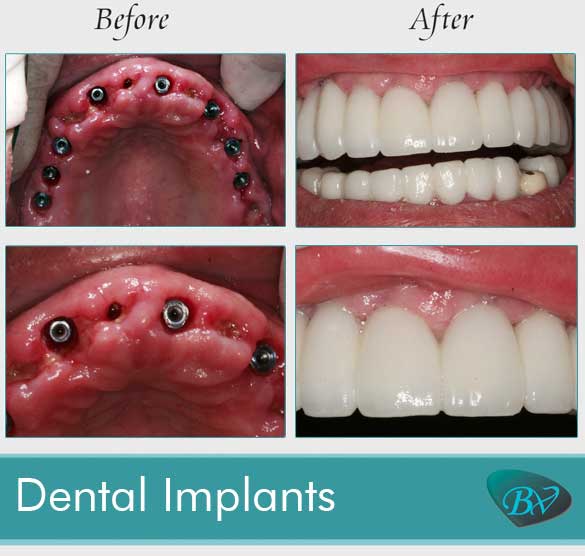Dental Sense Things To Know Before You Get This
Dental Sense Things To Know Before You Get This
Blog Article
The 4-Minute Rule for Dental Sense
Table of ContentsWhat Does Dental Sense Mean?Rumored Buzz on Dental SenseSome Of Dental SenseEverything about Dental Sense
are clinical gadgets surgically dental implanted right into the jaw to bring back a person's capacity to chew or their appearance. They offer support for artificial (fake) teeth, such as crowns, bridges, or dentures. When a tooth is lost as a result of injury or illness, an individual can experience problems such as fast bone loss, malfunctioning speech, or adjustments to chewing patterns that lead to discomfort.Dental dental implant systems include a dental implant body and dental implant abutment and may likewise consist of an abutment fixation screw. Kids dental. The dental implant body is operatively placed in the jawbone in location of the tooth's origin. The dental implant joint is usually connected to the implant body by the abutment addiction screw and extends with gum tissues into the mouth to support the attached man-made teeth
(https://medium.com/@matthewmusic33101/about)Structure of The Oral Implant System picking dental implants, speak with your oral provider concerning the prospective benefits and risks, and whether you are a candidate for the procedure. Points to think about: Your overall health and wellness is an essential aspect in establishing whether you are a good candidate for oral implants, for how long it will require to recover, and for how long the dental implant might stay in place.
Smoking might impact the healing procedure and reduce the long-lasting success of the implant. The healing procedure for the implant body may take several months or longer, throughout which time you generally have a short-term joint instead of the tooth. the dental implant procedure: Very carefully comply with the dental health guidelines offered to you by your dental supplier.
Little Known Questions About Dental Sense.
Implant failure can lead to the demand for one more operation to deal with or change the implant system. Brings back the capability to chew Restores cosmetic look Helps keep the jawbone from reducing due to bone loss Protects the health and wellness of the surrounding bone and gums Helps maintain surrounding (neighboring) teeth steady Improves top quality of life Damage to surrounding natural teeth during dental implant positioning Injury to the surrounding cells during surgery, such as sinus opening Injury during surgical treatment (for instance, fracture of bordering jawbone) Inadequate function, such as seeming like the teeth do not bite together usually An experience that the tooth hangs or twisting in position arising from a joint screw loosening up Implant body failing (looseness of the implant body) because of systemic infection, which might be most likely in patients with uncontrolled diabetics issues because of local infection in bone and periodontals supporting the read this article implant body because of postponed recovery, which may be more probable in clients that smoke Trouble cleansing the periodontals around the implant, resulting in poor oral hygiene Unattended periodontal disease Post-surgical pins and needles due to nerve impingement or damage Always notify health care carriers and imaging professionals that you have dental implants prior to any type of magnetic resonance imaging (MRI) or x-ray treatments.
FDA is not mindful of any type of damaging events reported for MRI or x-ray procedures with dental implants. Oral implants systems are normally constructed from products that follow international agreement requirements of the International Company for Standardization (ISO) or ASTM International. These requirements have details of what makes a safe product.

A dental implant is a framework that changes a missing out on tooth. With screw-like tools, the cosmetic surgeon inserts a dental implant right into the jawbone, and it serves as an anchor for a synthetic tooth, called a crown. A gadget called a joint attaches the fabricated tooth to the dental implant. The crown is personalized to fit the person's mouth and match the color of their teeth.
The Basic Principles Of Dental Sense
Some people are not qualified for dental implant surgical procedure. It is for oral doctors to operate on individuals with: severe illnessuncontrollable metabolic diseasebone or soft tissue disease or infectionIf these concerns are resolved, an individual can have the surgical procedure. In, dental cosmetic surgeons avoid operating on individuals with: If individuals with any one of the above go through oral implant surgery, there is a higher threat of the dental implant stopping working.

Dental implant surgical treatment is a personalized process. It's not the same for everybody. The complying with provides a general overview of what you can expect your dental expert, dental cosmetic surgeon, periodontist or prosthodontist to do: Put the dental implant operatively. Give you time to heal. Attach the post and last crown, bridge or denture.
Next, your cosmetic surgeon will carefully place the dental implant into your jaw. Your surgeon will certainly reposition your periodontals and close the cut with stitches. If your implant is near the front of your mouth, your dental practitioner will certainly make a short-lived tooth for you to put on up until you heal. By doing this, you won't have a gap in your smile while you recuperate.
The Facts About Dental Sense Revealed
Throughout the healing stage, your jawbone must fuse to the dental implant. This process can take anywhere from 3 to 9 months.
As soon as your implant heals, your dental professional can affix the abutment (tiny port post) and your final reconstruction (crown, bridge or denture). This usually takes regarding one hour to complete and might require a 2nd minor surgical treatment. You should not feel any type of pain throughout your dental implant procedure because your service provider will certainly use drug to numb your periodontals.
Report this page